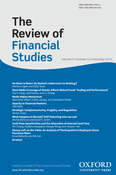-
Views
-
Cite
Cite
Yuki Sato, Opacity in Financial Markets, The Review of Financial Studies, Volume 27, Issue 12, December 2014, Pages 3502–3546, https://doi.org/10.1093/rfs/hhu047
Close - Share Icon Share
Abstract
This paper studies the implications of opacity in financial markets for investor behavior, asset prices, and welfare. Transparent funds (e.g., mutual funds) and opaque funds (e.g., hedge funds) trade transparent assets (e.g., plain-vanilla products) and opaque assets (e.g., structured products). Investors observe neither opaque funds' portfolios nor opaque assets' payoffs. Consistent with empirical observations, an “opacity price premium” arises: opaque assets trade at a premium over transparent ones despite identical payoffs. This accompanies endogenous market segmentation: transparent (opaque) funds trade only transparent (opaque) assets. The opacity price premium incentivizes financial engineers to render transparent assets opaque deliberately.




